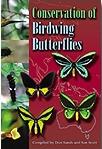|
[Front Page] [Features] [Departments] [Society Home] [Subscribe]

A Good Read
.....what's worth a look?
Reviews in this issue cover FieId guide to the wild flowers of Australia's south west: Augusta - Margaret River region by Jane Scott (illustrations by Patricia Negus), Conservation of Birdwing Butterflies edited by Don Sands and Sue Scott and four recently released CD-ROMs |
 |

 
FieId guide to the wild flowers of Australia's south west: Augusta - Margaret River region
Jane Scott (illustrations by Patricia Negus)
Published by Cape to Cape Publishing, North Fremantle, 2002.
Paperback, 224 A4 pages, with 102 full colour plates featuring 500 species.
$A39.95.
Reviewed by Tony Cavanagh
 
The area covered by this latest book on the wildflowers of Western Australia is very small indeed, just the coastal strip and some little distance inland between Augusta and a little north of Margaret River, the western half of the Augusta - Margaret River shire. Yet it includes many soil types and nearly a dozen different habitats, ranging from coastal dunes and heath through sandplains with areas of winter-wet swamps and wetlands to several types of woodlands, Jarrah - Marri and Karri Forest and even areas of granite outcrops. There are probably several thousand species of plants and the authors have done a masterly job in selecting 500 of the most important indigenous plants and weeds to illustrate and describe. The coast here is quite spectacular and in many areas largely undisturbed, being covered with plants able to withstand wind and salt spray, some growing right down to the sandy beach. It has a wonderful history as well. It was at present day Redgate Beach in December, 1876 that 16 year old Grace Bussell and aboriginal stockman Sam Isaac rescued 50 passengers from the wreck of the steamer Georgette, by swimming their horses numerous times over four hours through the raging surf. And the now largely forgotten plant and seed collector Georgina Molloy lived for some time at Augusta in the 1830s. This book is dedicated to her name.
The author, Jane Scott and botanical artist Patricia Negus are active members of the WA Regional Herbarium Project, a co-operative venture with the WA Herbarium whereby groups who collect and prepare herbarium specimens of their local flora receive expert advice and assistance with their naming. The specimens lodged in the Herbarium also contribute to an "improved knowledge of the State's floral diversity". In this way, members of local communities are made more aware of range and value of their flora, and can thus actively promote its conservation. The purpose of this book is to make available the information gathered over a three year period in the Augusta - Margaret River area. The plant information and illustrations are arranged taxonomically, ie firstly under family, then under genus. While such arrangement ensures that related species are grouped together, it may not be the most intuitive for the beginner. Nearly all the 500 species illustrations are paintings by Patricia Negus from herbarium specimens. She explains the main advantage of paintings: "...all the parts of the plant that are needed for identification: buds, flowers, fruits, leaves etc. can be brought into focus and arranged together. Painting also enables related plants to be grouped together on a page, and intertwined". Another advantage is that key parts of the plant can be shown enlarged.
I found the illustrations superb, extremely lifelike and if course, botanically accurate. They are ideal for field identification. Along with each species illustrated, Jane Scott gives the common name, the origin of the species name, a brief description, details of where it can be found and the flowering time in the area. Many of the species also grow widely through the south west. There is a separate section on the large number of weeds which unfortunately are now spreading in the south west. I remember being appalled seeing the huge tracts of native bush around Bussellton being infested with Arum lily, worse than anything I could remember in the east.
The book finishes with photos and brief accounts of the major habitats and a selection of species to be found in them, a glossary, excellent index and an up to date bibliography. There is also a useful species checklist appendix to allow the reader to keep a record of species they find.
This is an outstanding book and it shows what can be done by a small group of dedicated "amateurs". Both the quality of the plant reproductions and the general layout of the book are excellent, and the publishers have every right to be proud of their work which was wholly produced, printed and bound in Western Australia. I have one reservation and one minor criticism. I think that the A4 format, while admirable for reproduction of the paintings, is not really suitable for a field guide which many of us like to think of as something to carry in a back pack. Perhaps an A5 "field guide" might be considered in the future. Secondly, I still believe that it would be more useful for the reader if the species checklist were arranged alphabetically by species, rather than taxonomically. Very few of us have a complete understanding of taxonomic arrangements and having to enter a Stylidium on page 214 and then find where Synaphea is on page 210 is all too confusing for the average user. These minor points aside, I find this a delightful book and am very pleased to recommend it.
Reproduced from Growing Australian, newsletter of the Australian Plants Society (Victoria), June 2003.

 
Conservation of Birdwing Butterflies
Edited by Don Sands and Sue Scott
Published by SciComEd Pty Ltd and THECA (see contact details below), 2000.
48 pages, paperback.
$26.00 (including GST, postage and packaging)
Reviewed by Jan Sked
 
There has always been significant public interest in the conservation of the Richmond Birdwing Butterfly project and many thousands of people in northern New South Wales and south-eastern Queensland have planted the Richmond Birdwing Butterfly Vines (Pararistolochia praevenosa).
There have been reports of Birdwings visiting gardens and school grounds. The drought has had an impact on birdwing numbers, but, hopefully, people will continue planting and cultivating the vines to assist in restoring the Birdwings to their former range.
Thirteen years have now passed since the beginning of the Richmond Birdwing Conservation Project. The project is considered a flagship for community participation in a conservation project. Due to the dedication of community members, many natural lowland habitats of the Birdwing are now protected and managed in a way that will ensure it is no longer at risk of extinction.
This book summarises the conservation efforts for the Richmond Birdwing and also contains examples of other international birdwing conservation projects.
It contains many never-before published photographs, including the emergence of the Richmond Birdwing from its pupa, and photographs the story of the Paradise Birdwing subspecies from Madang, Papua New Guinea, that was recently rediscovered after not being sighted for 50 years.
The book is available from:
SciComEd Pty Ltd (Science communication and Educational Services), 2 Emily Street, Marsden, Queensland. 4132.
Phone 07 3200 7432
Email: Susanne.Scott@bigpond.com
Reproduced from the Bulletin, newsletter of the Society for Growing Australian Plants (Queensland), September 2003.

 
A Review of CD-ROMs
Various authors
These reviews are based on a talk given to the Sutherland Group of the Australian Plants Society. The talk was summarised by Ruchir Sodhani. The CDs reviewed are:
- Plants of Australia by Denise Greig (reviewed by Doug Irvine)
- Families of Flowering Plants of Australia: An Interactive Identification Guide published by CSIRO (reviewed by Doug Irvine)
- Eucalypts of Southern Australiapublished by CSIRO (reviewed by Doug Irvine)
- Plantfile by Peter Kirkland (reviewed by Doug Rickard)
Plants of Australia
This CD ROM illustrates and describes plants from all across Australia and provides helpful information about common Australian habitats using 'field trip' multimedia presentations. These presentations have a commentary about the habitats and its plants and animals as you watch a movie or a series of images. Over 700 plants have been illustrated with good quality photographs and descriptions in simple language. It also contains a lookup index, plant categories, screen savers, games, jigsaws and puzzles.
The plant list is far from complete and illustrations are restricted to one per plant. Overall, it is of value to junior school students and tourists to get an appreciation of the variety of Australian plants and habitats. It is easy to use and is affordable at $50. Doug found little incentive to use the CD more than once. The CD is not useful for plant identification.
Families of Flowering Plants of Australia: An Interactive Identification Guide
This CD contains authoritative descriptions of all Australian plant families and includes a plant identification section that refers to many characteristics and features such as leaf shape and habitat. Each characteristic is defined and illustrated by a line drawing or a photograph. The user can choose between displaying all characteristics or a convenient subset, e.g. stems and leaves only. Doug found the CD useful for its descriptions, the interactive identification process and good photography. However, the language used is very technical, the illustrations are incomplete and the examples are sparse. To plant enthusiasts it is annoying that the key only works to the family level. So, you can get down to Myrtaceae but not to Eucalyptus. The limitation of the search criteria is that if you get one characteristic of a plant wrong, you will automatically eliminate the plant you are looking for. Doug found this to be too 'unforgiving'. The CD is reasonably priced at around $70.
(For a more detailed review of this CD, see Australian Plants online, December 2002 issue).
Eucalypts of Southern Australia
The interface is similar to that used by the previous CD ROM, but is more user-friendly. As the CD restricts itself to eucalypts, it goes into much more detail about each species. A total of 113 characters are covered such as habit, bark, leaves, flowers, fruits, buds, seeds and juveniles as well as geographical distribution. It is an expensive CD, costing about $120 and is likely to have a broad appeal in the forestry, gardening, conservation, and student community. Like the second CD, the search capabilities are unforgiving. However, the interactive guide is useful and the illustrations are exhaustive. It is an excellent alternative to the common plant identification guides when it comes to local eucalypts.
Plantfile
The author, Peter Kirkland, is experienced in the landscaping industry. This CD ROM is intended for home gardeners, landscapers and nurserymen, or anyone who wants to know what plant to put where, and what flowering plant is that? It has a searchable database of over 200 native and 800 exotic plants with information on the type of soil, ideal growing conditions, pruning, flowering season, etc. It also includes a plant identification section. Costing around $140, this CD ROM attempts to fill a gap not adequately covered by books on the subject.
Reproduced from inPlant, newsletter of the Sutherland Group of the Australian Plants Society, September 2003.

[Front Page] [Features] [Departments] [Society Home] [Subscribe]
Australian Plants online - December 2003
Association of Societies for Growing Australian Plants
|